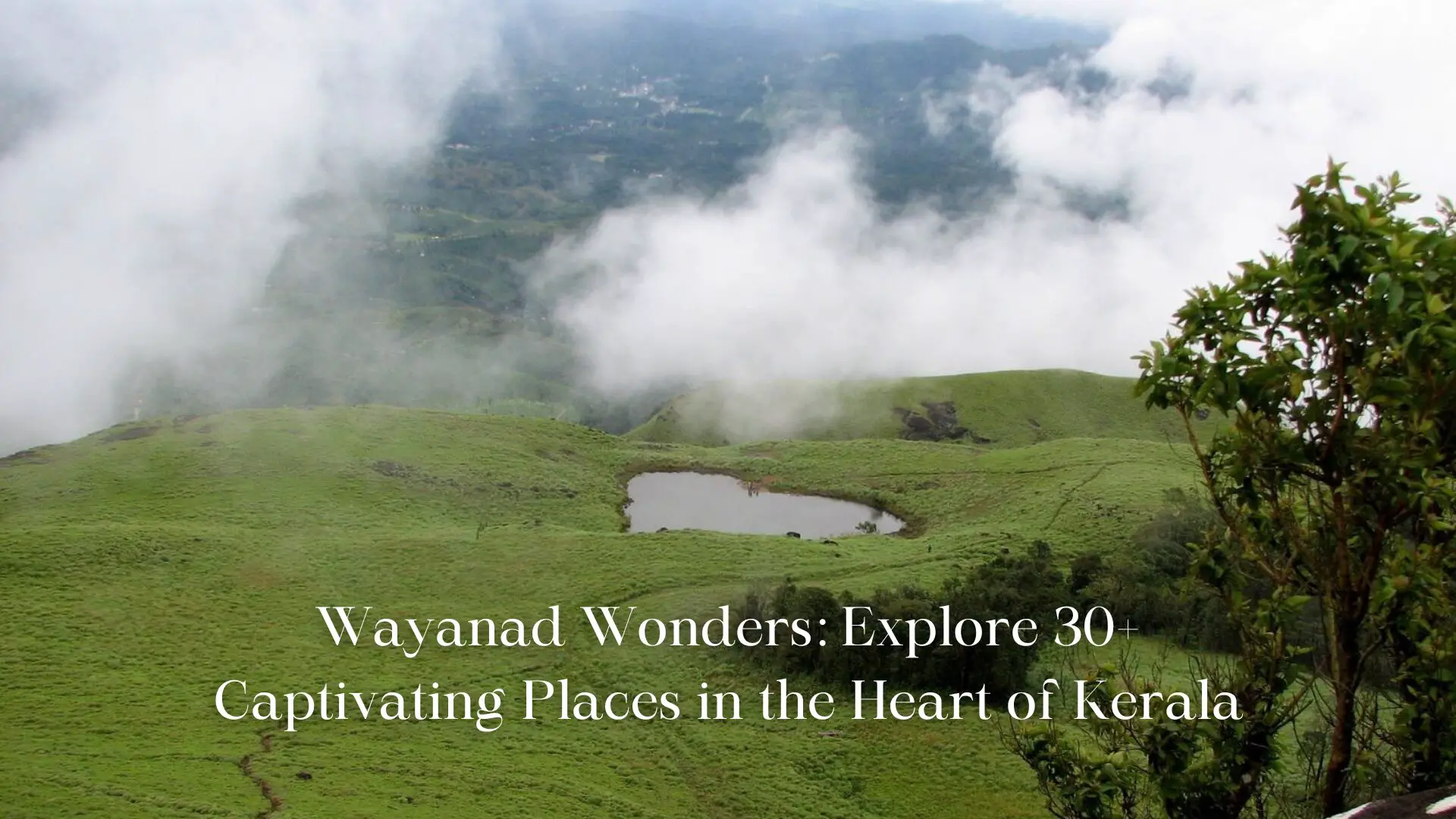Nestled along the picturesque Malabar Coast of Kerala, Alleppey, also known as Alappuzha, is a mesmerizing destination that epitomizes the essence of God’s Own Country. With its intricate network of backwaters, serene lakes, and lush green landscapes, Alleppey beckons travelers to experience a tranquil and enchanting getaway. As we step into the year 2024, let’s explore the 20+ best places to visit in Alleppey, ensuring an unforgettable travel experience.
Alleppey Backwaters: A Tranquil Odyssey into Nature’s Embrace
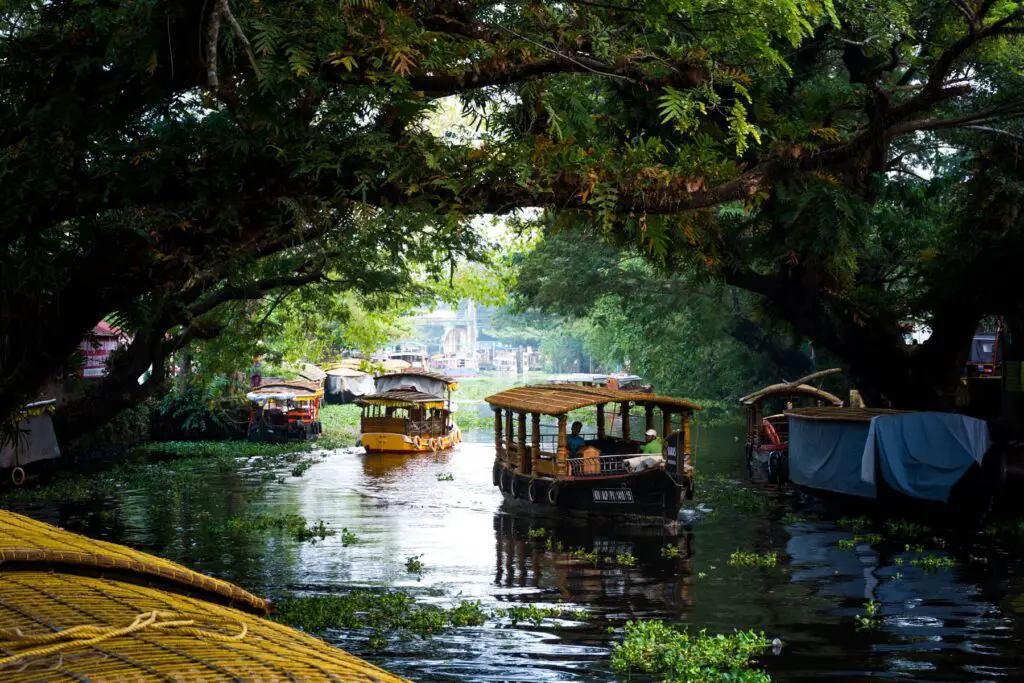
Nestled along the serene Malabar Coast of Kerala, Alleppey, often referred to as the Venice of the East, beckons travelers with its enchanting backwaters. This picturesque network of canals, lakes, and lagoons forms the heart and soul of Alleppey, offering an unparalleled experience that seamlessly blends nature’s beauty with cultural heritage. Join us on a virtual journey as we explore the allure of the Alleppey backwaters, a tranquil odyssey into nature’s embrace.
The Backwater Symphony:
- Alleppey’s backwaters compose a symphony of nature, where the gentle ripples of water and the rustling of palm leaves create a soothing melody. Embark on a houseboat or canoe, and let the rhythmic sounds of the backwaters serenade you into a state of tranquility.
Houseboat Cruises:
- A quintessential Alleppey experience involves drifting along the backwaters on a traditional houseboat, locally known as ‘kettuvallam.’ These well-appointed floating abodes provide a unique vantage point to witness the picturesque landscapes, quaint villages, and vibrant local life.
Paddy Fields and Coconut Groves:
- The backwaters of Alleppey are fringed by lush green paddy fields and coconut groves, creating a mesmerizing panorama. As you cruise along, marvel at the emerald hues that stretch as far as the eye can see, offering a glimpse into the agrarian life of the region.
Village Life Along the Banks:
- The backwaters serve as a lifeline for the communities that thrive along their banks. Witness the simplicity of village life, where locals engage in fishing, traditional farming, and daily chores. It’s a glimpse into a way of life that feels suspended in time.
Birdwatcher’s Paradise:
- Alleppey’s backwaters are a haven for bird enthusiasts. Keep your eyes peeled for a variety of avian species, including kingfishers, egrets, and migratory birds. Pathiramanal Island, situated in the Vembanad Lake, is particularly renowned for its birdwatching opportunities.
Sunset Spectacle:
- There’s something magical about witnessing the sunset over the backwaters. The sky transforms into a canvas of warm hues, casting a golden glow over the tranquil waters. Capture this breathtaking moment as the sun dips below the horizon, painting the backwaters in a palette of oranges and pinks.
Ayurvedic Wellness Cruises:
- Elevate your experience with an Ayurvedic wellness cruise. Many houseboats offer rejuvenating spa treatments and traditional Ayurvedic meals, providing a holistic approach to relaxation amidst the natural beauty of the backwaters.
Alleppey Backwater Festival:
- Plan your visit around the Alleppey Backwater Festival to witness vibrant boat races, cultural performances, and a lively atmosphere. The festival, usually held in August, celebrates the significance of the backwaters in the local heritage.
Vembanad Lake: Kerala’s Jewel of Tranquility

Nestled in the heart of Kerala, Vembanad Lake stands as a serene jewel, captivating travelers with its vast expanse of shimmering waters and picturesque landscapes. As the largest lake in the state, Vembanad is not merely a water body but a sanctuary of tranquility that weaves together nature’s beauty, cultural richness, and an inviting aura. Join us as we embark on a journey to explore the enchanting allure of Vembanad Lake, a testament to Kerala’s unmatched natural splendor.
The Magnitude of Vembanad:
- Vembanad Lake sprawls across an impressive 96 kilometers, making it the longest lake in India and the largest in the state of Kerala. Its sheer magnitude sets the stage for a breathtaking spectacle of nature that unfolds as you traverse its tranquil waters.
Houseboats and Backwater Cruises:
- The allure of Vembanad is best experienced aboard the traditional Kettuvallams or houseboats. Drift along the lake’s gentle waves and witness the beauty of the surrounding landscapes, from emerald-green paddy fields to quaint villages nestled along the shores.
Pathiramanal Island:
- Anchored in the middle of Vembanad Lake, Pathiramanal Island is a haven for birdwatchers. This idyllic island sanctuary provides refuge to a variety of migratory birds, creating a symphony of avian melodies that adds to the tranquility of the lake.
Kumarakom:
- Vembanad’s embrace extends to the enchanting Kumarakom, a cluster of islands on the eastern shores of the lake. Here, lush greenery, coconut groves, and vibrant birdlife create a paradise for those seeking a retreat into nature’s lap.
Nehru Trophy Boat Race:
- Vembanad Lake comes alive during the annual Nehru Trophy Boat Race, a thrilling event that attracts spectators from around the world. Experience the excitement as snake boats glide gracefully over the lake’s waters, showcasing the traditional sport of Kerala.
Kumarakom Bird Sanctuary:
- Adjacent to Vembanad, the Kumarakom Bird Sanctuary offers a haven for bird enthusiasts. Explore its trails and spot a myriad of bird species, including kingfishers, egrets, and the elusive Siberian Crane during the migratory season.
Thanneermukkom Bund:
- This massive bund separates Vembanad Lake from the Arabian Sea, showcasing an engineering marvel that prevents saltwater intrusion into the freshwater lake. The bund provides a panoramic view of the expansive lake and the surrounding landscape.
Sunset Cruises:
- Witness the magical transformation of Vembanad during sunset. Opt for a leisurely evening cruise, and as the sun dips below the horizon, the lake’s waters reflect a kaleidoscope of colors, creating a mesmerizing tableau.
Alappuzha Beach: Where Sun, Sand, and Serenity Converge

Along the picturesque Malabar Coast of Kerala lies a coastal gem that epitomizes the essence of tranquility and natural beauty – Alappuzha Beach. Also known as Alleppey Beach, this idyllic stretch of golden sands invites travelers to unwind amidst the rhythmic sounds of waves, offering a perfect blend of sun, sand, and serenity. Join us as we delve into the allure of Alappuzha Beach, a haven where time seems to stand still.
Golden Sands and Azure Waters:
- Alappuzha Beach boasts miles of pristine golden sands that gently kiss the azure waters of the Arabian Sea. Whether you’re strolling along the shoreline, building sandcastles, or simply basking in the sun, the beach provides a canvas of tranquility against the backdrop of endless horizons.
Picturesque Alappuzha Pier:
- The iconic Alappuzha Pier stands as a silent witness to the changing tides and the passage of time. Stretching into the sea, the pier offers panoramic views of the coastline, making it an ideal spot to capture the beauty of the beach and the expansive horizon.
Sunset Magic:
- Alappuzha Beach is renowned for its mesmerizing sunsets. As the sun dips below the horizon, the sky transforms into a palette of warm hues, casting a golden glow over the sea. Witnessing the sunset at Alappuzha Beach is an ethereal experience that lingers in the memory.
Lighthouse for Panoramic Views:
- Ascend the Alappuzha Lighthouse for breathtaking panoramic views of the beach and the Arabian Sea. The vantage point from the top provides a unique perspective of the coastal landscape and the vibrant life that thrives along the shores.
Coconut Trees and Casuarina Groves:
- Alappuzha Beach is fringed with swaying coconut trees and casuarina groves, offering natural shade and a refreshing breeze. The verdant greenery enhances the coastal charm, providing a serene backdrop for leisurely strolls along the shore.
Fishing Activities:
- Experience the authentic coastal life as you observe local fishermen engaged in traditional fishing activities. The sight of colorful fishing boats bobbing on the waves adds to the picturesque charm of Alappuzha Beach.
Alappuzha Sea Bridge:
- A walk along the Alappuzha Sea Bridge is a must-do for visitors. This bridge connects Alappuzha Beach to the town and offers splendid views of the coast. It’s an ideal spot for a leisurely evening stroll, enjoying the sea breeze and the vibrant atmosphere.
Rejuvenation at Ayurvedic Spas:
- Pamper yourself with rejuvenating Ayurvedic treatments offered by beachside spas. Let the soothing sounds of the waves complement the healing touch of traditional Ayurvedic therapies, creating a holistic experience by the sea.
Kuttanad: Kerala’s Green Symphony of Backwaters and Paddy Fields

Nestled in the heart of Kerala, Kuttanad unfolds like a vibrant tapestry of greenery, waterways, and traditional village life. Known as the “Rice Bowl of Kerala,” this enchanting region is a testament to the state’s agrarian heritage, where emerald-green paddy fields and serene backwaters create a harmonious symphony of nature. Join us as we explore the timeless allure of Kuttanad, a destination where the pastoral beauty of Kerala comes to life.
The Rice Bowl of Kerala:
- Kuttanad is aptly named the “Rice Bowl of Kerala” due to its vast expanse of paddy fields. The region is renowned for its unique below-sea-level farming, a feat of agricultural engineering that has sustained generations of farmers.
Backwaters Labyrinth:
- The intricate network of backwaters in Kuttanad is a defining feature of the region’s landscape. Embark on a mesmerizing houseboat journey, meandering through narrow canals shaded by coconut palms, offering a glimpse into the peaceful and rustic charm of village life.
Traditional Kettuvallams:
- Witness the iconic Kettuvallams, traditional houseboats adorned with intricate woodwork and thatched roofs. These floating abodes provide a unique and immersive way to experience the tranquility of Kuttanad’s backwaters.
Pamba River:
- Flowing through Kuttanad, the Pamba River adds to the scenic beauty of the region. Take a boat ride along the Pamba to appreciate the lush greenery, coconut groves, and the simplicity of riverside village life.
Chavara Bhavan:
- Pay a visit to Chavara Bhavan, the ancestral home of the blessed Kuriakose Elias Chavara. This spiritual center is a pilgrimage site for devotees and showcases the life and teachings of the saint.
Vibrant Village Life:
- Kuttanad offers a glimpse into the traditional lifestyle of Kerala’s villages. Explore local markets, interact with farmers in the paddy fields, and witness the simplicity of daily life in these charming villages.
Thakazhi Memorial:
- Discover the legacy of Thakazhi Sivasankara Pillai, a renowned Malayalam writer, at the Thakazhi Memorial. The museum showcases the life and works of this literary giant, providing insights into Kerala’s cultural richness.
Nehru Trophy Boat Race:
- Kuttanad hosts the prestigious Nehru Trophy Boat Race, a thrilling event where snake boats compete in a vibrant display of Kerala’s traditional sport. The race, held on the Punnamada Lake, attracts spectators from far and wide.
Pathiramanal Island:
- Sail to Pathiramanal Island, an avian paradise in the midst of Vembanad Lake. Birdwatchers can revel in the sight of migratory birds that find sanctuary on this island, making it a must-visit destination for nature enthusiasts.
Karumadikuttan:
- Visit Karumadikuttan, an ancient granite statue of Lord Buddha, believed to date back to the 9th or 10th century. The serene ambiance of this archaeological site adds a touch of spirituality to the cultural landscape of Kuttanad.
Krishnapuram Palace: A Glimpse into Kerala’s Royal Heritage

Nestled amidst the verdant landscapes of Alleppey in Kerala, Krishnapuram Palace stands as a testament to the state’s rich cultural and architectural heritage. This magnificent palace, steeped in history, offers visitors a captivating journey back in time, revealing the opulence and grandeur of Kerala’s royal past. Join us as we explore the enchanting story of Krishnapuram Palace, where regality meets architectural splendor.
Architectural Marvel:
- Krishnapuram Palace, built in the 18th century during the reign of Maharaja Marthanda Varma, is a splendid example of Kerala’s traditional architecture. The palace showcases the unique characteristics of Nalukettu style, featuring a central courtyard and a traditional sloping roof.
Gajendra Moksha Mural:
- One of the highlights of Krishnapuram Palace is the Gajendra Moksha mural, a masterpiece that spans an entire wall. This mural narrates the mythological tale of Lord Vishnu rescuing the elephant Gajendra from the clutches of a crocodile, portraying exquisite artistic finesse and detailing.
Antique Collections:
- The palace houses an impressive collection of antiques, artifacts, and historical objects that provide a glimpse into the lifestyle and tastes of the erstwhile Travancore rulers. From ancient coins to intricately carved wooden furniture, each piece reflects the cultural richness of the bygone era.
Archaeological Museum:
- Krishnapuram Palace also functions as an archaeological museum, displaying artifacts dating back to the 8th century. The museum showcases sculptures, bronze idols, ancient utensils, and artifacts, offering visitors a comprehensive view of Kerala’s cultural evolution.
Ottoman-Era Carpets:
- Among the treasures housed in Krishnapuram Palace are a set of exquisite carpets from the Ottoman era. These rare and intricately woven carpets, believed to have been gifted to the Maharaja by the Dutch traders, add a touch of international allure to the palace’s collection.
Dutch Influence:
- The palace has strong ties to the Dutch East India Company, and its architecture reflects a blend of indigenous Kerala style and Dutch influences. The palace is an architectural gem that stands as a living testimony to the historical interactions between Kerala and the European powers.
Surrounding Gardens:
- Krishnapuram Palace is set amidst lush, well-maintained gardens that enhance its regal ambiance. The gardens provide a serene environment for visitors to stroll, offering a moment of tranquility amidst the historical grandeur.
Accessibility and Location:
- Located approximately 47 kilometers from Alleppey, Krishnapuram Palace is easily accessible by road. Its strategic location allows visitors to combine their visit with other nearby attractions, creating a wholesome experience of the cultural and natural wonders of the region.
Pathiramanal Island: Kerala’s Avian Paradise on Vembanad Lake
Floating like a jewel on the serene waters of Vembanad Lake in Kerala, Pathiramanal Island beckons travelers to embark on a journey into nature’s embrace. This picturesque island, with its lush greenery and tranquil surroundings, is a haven for bird enthusiasts and nature lovers. Join us as we explore the enchanting allure of Pathiramanal Island, a serene escape where the beauty of Kerala’s backwaters meets a symphony of avian life.
Island of Midnight Sands:
- The name “Pathiramanal” translates to “midnight sands,” a fitting moniker for an island that unveils its mystical charm in the soft glow of moonlight. This secluded sanctuary is a tranquil escape from the bustling world, accessible only by boat.
Birdwatcher’s Paradise:
- Pathiramanal Island is renowned as a birdwatcher’s paradise, attracting avian enthusiasts from around the globe. The island serves as a pitstop for migratory birds, offering a sanctuary for species like terns, gulls, cormorants, and even the rare Siberian Crane during the winter months.
Idyllic Backwater Setting:
- Surrounded by the pristine waters of Vembanad Lake, the island is set against the backdrop of Kerala’s famous backwaters. The idyllic setting provides a perfect canvas for nature lovers to immerse themselves in the beauty of Kerala’s unique ecosystem.
Boat Rides and Access:
- Reachable by a leisurely boat ride from Alappuzha or Kumarakom, the journey to Pathiramanal Island is an experience in itself. As you cruise through the labyrinth of backwaters, the anticipation builds, setting the stage for the natural wonders that await.
Biodiversity on Display:
- The biodiversity on Pathiramanal is captivating, with its rich variety of flora and fauna. The island is home to diverse species of butterflies, insects, and medicinal plants, creating a harmonious ecosystem that adds to the allure of the surroundings.
Thanneermukkom Bund View:
- From certain vantage points on Pathiramanal Island, visitors can enjoy panoramic views of the Thanneermukkom Bund. This massive bund separates the saltwater of the Arabian Sea from the freshwater of Vembanad Lake, showcasing an engineering marvel against the backdrop of lush greenery.
Pristine Beaches:
- The island features pristine sandy beaches along its shoreline, inviting visitors to relax and enjoy the tranquility of the surroundings. The gentle lapping of the waves against the shore creates a soothing ambiance, making it an ideal spot for a peaceful retreat.
Conservation and Preservation:
- Efforts are ongoing to preserve the natural habitat of Pathiramanal Island. The Kerala State Biodiversity Board and local authorities work to maintain the ecological balance, ensuring that the island remains a sanctuary for migratory birds and a haven for nature enthusiasts.
Ambalappuzha Sri Krishna Temple: A Spiritual Haven Amidst Kerala’s Backwaters

Nestled in the tranquil backwaters of Kerala, the Ambalappuzha Sri Krishna Temple stands as a testament to the rich cultural and spiritual heritage of God’s Own Country. This ancient temple, dedicated to Lord Krishna, holds not only religious significance but also architectural and historical allure. Join us as we embark on a virtual journey to explore the mystical ambiance and spiritual vibrancy of Ambalappuzha Sri Krishna Temple.
Architectural Elegance:
- The Ambalappuzha Sri Krishna Temple showcases exquisite traditional Kerala temple architecture. The intricate wooden carvings, gabled roofs, and distinctive temple structures reflect the timeless craftsmanship of the region.
Idol of Lord Krishna:
- The presiding deity of the temple is Lord Parthasarathy, an incarnation of Lord Krishna. The main idol is made of a unique combination of materials known as “kadu-sharkara-yogam,” a mix of sacred materials with medicinal properties.
Daily Rituals and Offerings:
- The temple is known for its elaborate daily rituals, including the famous ‘Palpayasam Nivedyam.’ Devotees offer a sweet rice-milk porridge to the deity, and it is believed that Guruvayurappan visits the temple daily to partake in this offering.
Famous Ambalappuzha Palpayasam:
- The Ambalappuzha Palpayasam is a sweet dish made with rice, milk, and sugar, believed to be the favorite of Lord Krishna. Legend has it that the deity comes to the temple disguised as a sage to savor this delectable offering.
Murals and Artistic Marvels:
- Adorning the temple walls are vibrant murals depicting various episodes from the Mahabharata and other mythological tales. These intricate artworks are a visual treat for visitors, providing glimpses into ancient storytelling traditions.
Ambalappuzha Temple Festival:
- The Ambalappuzha Temple Festival is an annual event that attracts devotees and tourists alike. The festival, held in the Malayalam month of Meenam (March-April), features traditional music, dance, processions, and rituals, creating a vibrant and joyous atmosphere.
Krishna’s Narayana Giri:
- The temple is famous for its ‘Narayana Giri,’ a mountain-like structure believed to have been created by Lord Krishna himself. Devotees circumambulate this sacred hill, seeking blessings and divine intervention in their lives.
Divine Musical Instrument:
- The temple is known for the ‘Ambalappuzha Vijayakrishnan,’ a unique musical instrument believed to be a divine gift from Lord Krishna. This instrument is played during special occasions and adds a melodic touch to the temple rituals.
Spiritual Ambiance:
- Surrounded by serene backwaters, the Ambalappuzha Sri Krishna Temple exudes a tranquil and spiritual ambiance. The scenic beauty of its surroundings enhances the overall experience, offering devotees and visitors a peaceful retreat.
Historical Significance:
- With a history dating back several centuries, the Ambalappuzha Sri Krishna Temple has witnessed the ebb and flow of time. Its walls echo with tales of devotion, culture, and the enduring spiritual legacy of the region.
Marari Beach: Kerala’s Hidden Coastal Gem
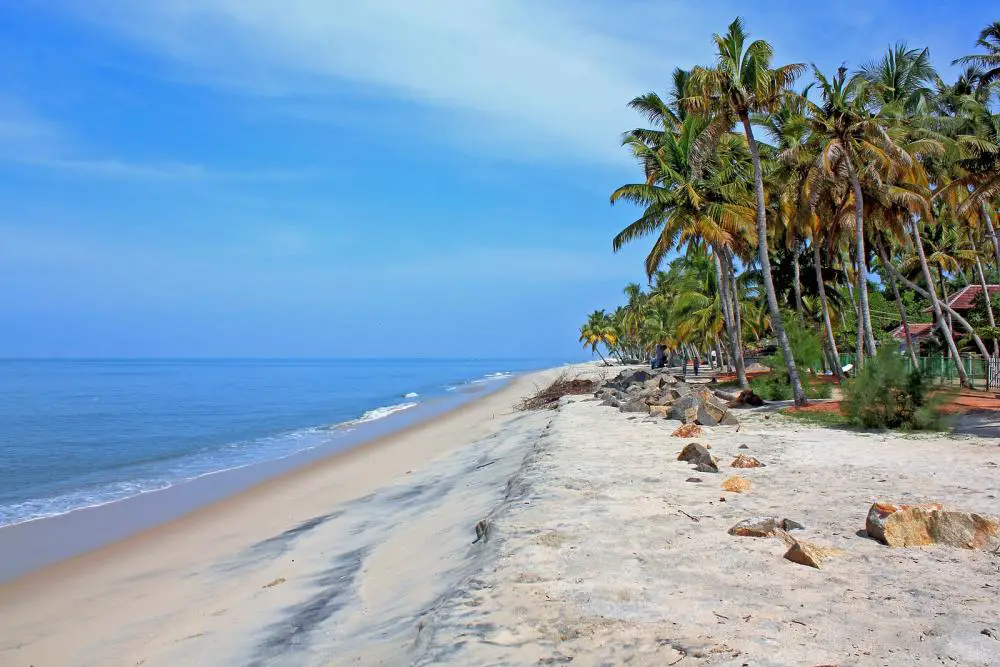
Tucked away along the Malabar Coast of Kerala, Marari Beach emerges as a hidden coastal gem, inviting travelers to escape into a world of pristine sands, azure waters, and serene tranquility. Away from the bustling tourist hubs, Marari Beach promises a tranquil retreat where the rhythmic sounds of waves provide a symphony for the soul. Join us on a journey to explore the unspoiled beauty and laid-back charm of Marari Beach, a destination that epitomizes the essence of God’s Own Country.
Unspoiled Beauty of Marari:
- Marari Beach remains relatively untouched by commercialization, offering visitors an unspoiled and authentic experience. The miles of golden sands stretching along the Arabian Sea create a serene and picturesque setting.
Azure Waters and Gentle Waves:
- The beach is blessed with clear blue waters that gently kiss the shore. The rhythmic lull of the waves creates a soothing ambiance, inviting visitors to relax, unwind, and let the worries of the world wash away with the tide.
Traditional Fishing Village Vibes:
- Adjacent to the beach lies a traditional fishing village, providing a glimpse into the coastal way of life in Kerala. Witness the colorful fishing boats returning with their daily catch and experience the warm hospitality of the local community.
Ayurvedic Wellness by the Beach:
- Marari Beach offers a tranquil setting for Ayurvedic wellness. Rejuvenate your body and mind with traditional Ayurvedic treatments, massages, and yoga sessions right by the beach, where the calming sound of the waves enhances the therapeutic experience.
Luxurious Beach Resorts:
- Despite its secluded charm, Marari Beach is home to a range of luxurious beach resorts that seamlessly blend with the natural surroundings. From eco-friendly cottages to elegant villas, these accommodations offer a perfect blend of comfort and serenity.
Vibrant Village Markets:
- Explore the vibrant local markets near Marari Beach, where you can witness the daily life of the community. Pick up handmade souvenirs, spices, and traditional crafts, supporting local artisans and businesses.
Kerala Culinary Delights:
- Indulge in the rich flavors of Kerala’s culinary delights right by the beach. Fresh seafood, coconut-infused curries, and traditional dishes served at beachside shacks and restaurants provide a gastronomic journey into the heart of Kerala’s culinary heritage.
Bicycle Tours and Nature Walks:
- Marari Beach is ideal for leisurely bicycle tours and nature walks. Explore the surrounding landscapes, visit nearby villages, and immerse yourself in the natural beauty that defines this coastal haven.
Spectacular Sunsets:
- Marari Beach is renowned for its spectacular sunsets over the Arabian Sea. As the sun dips below the horizon, the sky transforms into a canvas of vibrant hues, casting a warm glow over the tranquil waters.
Eco-Friendly Initiatives:
- Embracing sustainable tourism, Marari Beach is known for its eco-friendly initiatives. Resorts and local communities work together to preserve the natural beauty of the area, making it an ideal destination for responsible travelers.
Punnamada Lake: A Tranquil Oasis on Kerala’s Backwaters

Nestled in the heart of Kerala’s enchanting backwaters, Punnamada Lake emerges as a serene oasis, inviting travelers to immerse themselves in the tranquil beauty of God’s Own Country. This expansive water body, known for its picturesque landscapes and cultural significance, is a testament to Kerala’s unique allure. Join us as we embark on a virtual journey to explore the pristine charm and cultural richness surrounding Punnamada Lake.
Geographical Splendor:
- Punnamada Lake, situated in Alappuzha (Alleppey), is a sprawling freshwater lake that forms an integral part of the intricate network of Kerala’s backwaters. Its shimmering waters, fringed by coconut palms and lush greenery, create a postcard-worthy scene.
Nehru Trophy Boat Race:
- Punnamada Lake is famed for hosting the annual Nehru Trophy Boat Race, one of Kerala’s most iconic events. Held on the second Saturday of August, the race transforms the placid lake into a vibrant arena, drawing spectators and participants from around the world.
Houseboat Cruises:
- A visit to Punnamada Lake is incomplete without experiencing a leisurely houseboat cruise. The traditional Kettuvallams, adorned with intricate woodwork and modern amenities, offer a unique vantage point to witness the scenic beauty and local life along the lake’s shores.
Champakulam Moolam Boat Race:
- Apart from the Nehru Trophy, Punnamada Lake hosts the Champakulam Moolam Boat Race, another significant event in the region. This race, held during the Moolam day of the Malayalam month of Midhunam, adds to the cultural vibrancy of the lake.
Islands and Villages:
- The lake is dotted with picturesque islands and charming villages that add to its natural charm. Explore these islands to witness the traditional lifestyle of the locals, and marvel at the scenic beauty that surrounds them.
Birdwatching Delight:
- Punnamada Lake is a haven for birdwatchers. The peaceful ambiance and rich biodiversity attract a variety of avian species, making it a delightful spot for nature enthusiasts. Keep an eye out for kingfishers, herons, and other migratory birds.
Coconut Groves and Paddy Fields:
- The lake’s shores are adorned with coconut groves and vibrant paddy fields, creating a picturesque panorama. The sight of swaying coconut palms and lush green fields reflects the agrarian essence of Kerala’s backwater landscapes.
Sunset Splendor:
- Witnessing the sunset over Punnamada Lake is a mesmerizing experience. As the sun dips below the horizon, the sky transforms into a canvas of warm hues, casting a golden glow over the tranquil waters.
Ayurvedic Wellness Retreats:
- Some resorts along the lake offer Ayurvedic wellness retreats, allowing visitors to rejuvenate amidst the natural beauty of Punnamada. Indulge in traditional Ayurvedic treatments and spa therapies while surrounded by the serene ambiance of the backwaters.
Cultural Immersion:
- Punnamada Lake offers a unique opportunity for cultural immersion. Interact with the friendly locals, partake in traditional festivities, and savor authentic Kerala cuisine, creating memories that reflect the true spirit of this picturesque destination.
Mullakkal Rajarajeswari Temple: A Sacred Abode Amidst Alleppey’s Rich Heritage
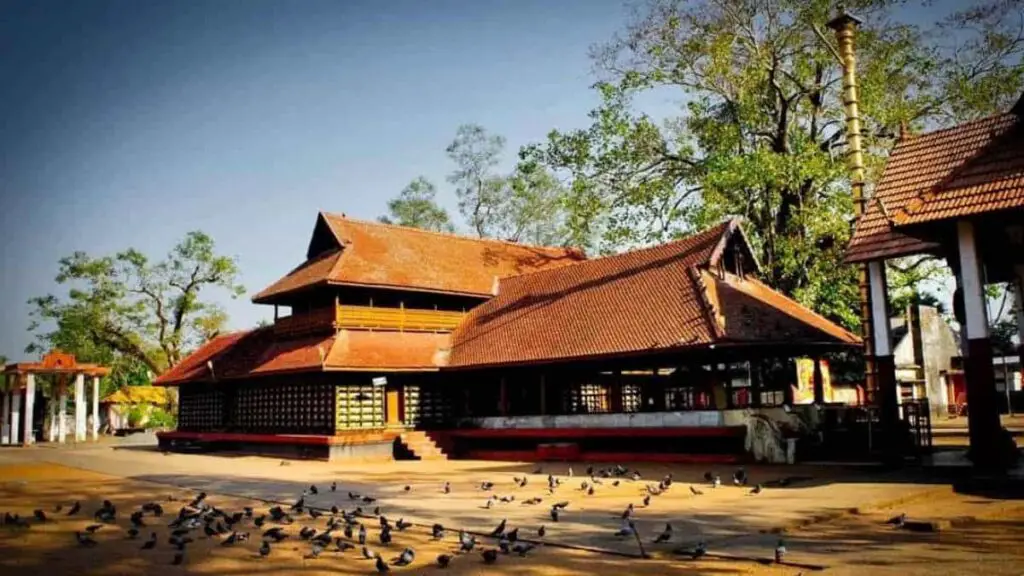
Nestled in the cultural tapestry of Alleppey (Alappuzha), the Mullakkal Rajarajeswari Temple stands as a testament to the spiritual heritage of Kerala. Dedicated to Goddess Rajarajeswari, this ancient temple carries the weight of centuries of devotion and cultural significance. Join us on a virtual pilgrimage as we explore the divine sanctity, architectural brilliance, and cultural richness of the Mullakkal Rajarajeswari Temple.
Historical Roots:
- The Mullakkal Rajarajeswari Temple boasts a history that dates back several centuries. With its roots embedded in the cultural landscape of Kerala, the temple has witnessed the ebb and flow of time, preserving the essence of tradition and devotion.
Architectural Grandeur:
- The temple’s architecture is a harmonious blend of traditional Kerala style and intricate detailing. The sanctum sanctorum, adorned with delicate carvings and vibrant paintings, reflects the artistic brilliance of the craftsmen of yesteryears.
Goddess Rajarajeswari:
- At the heart of the temple lies the divine idol of Goddess Rajarajeswari, the presiding deity. Devotees believe that seeking the blessings of the goddess brings prosperity, harmony, and protection from adversities.
Mullakkal Pooram:
- The Mullakkal Rajarajeswari Temple hosts the annual Mullakkal Pooram, a grand festival that attracts devotees and tourists alike. The festival, celebrated with fervor, features traditional music, dance, and cultural performances, creating a vibrant ambiance.
Spiritual Significance:
- Devotees from far and wide visit the temple to seek the divine blessings of Goddess Rajarajeswari. The spiritual aura of the temple, coupled with the rhythmic chants and the fragrance of incense, creates an atmosphere conducive to introspection and devotion.
Temple Pond:
- The temple complex features a sacred pond, often referred to as the ‘Pushkarini.’ Devotees believe that taking a dip in the holy waters of the pond purifies the soul and enhances the spiritual connection with the goddess.
Traditional Rituals:
- The Mullakkal Rajarajeswari Temple follows a rich tapestry of daily rituals and ceremonies. Witnessing the ‘Pooja’ and ‘Nivedyam’ offered to the goddess provides visitors with a glimpse into the age-old customs that define the temple’s cultural heritage.
Festive Celebrations:
- Besides the Mullakkal Pooram, the temple observes various other festivals, including Navaratri, Makara Vilakku, and Thiruvathira, each adding a unique layer of cultural celebration to the spiritual fabric of the temple.
Cultural Extravaganza:
- The temple premises often serve as a venue for cultural events, showcasing traditional dance forms, music, and art. These events contribute to the preservation and promotion of Kerala’s rich cultural heritage.
Community Engagement:
- The Mullakkal Rajarajeswari Temple actively engages with the local community, fostering a sense of unity and cultural pride. The temple plays a pivotal role in promoting social welfare activities and contributing to the well-being of the surrounding region.
St. Mary’s Forane Church: A Spiritual Haven in God’s Own Country
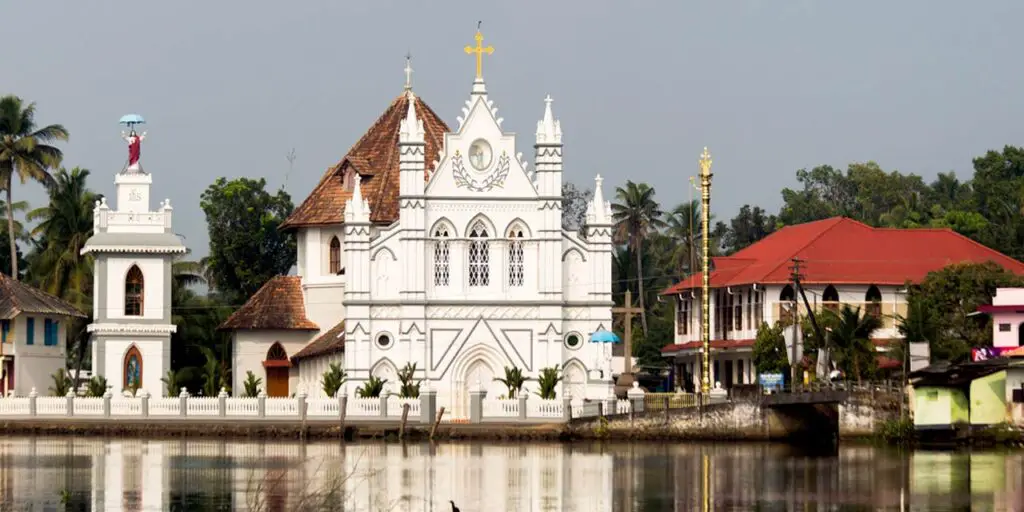
Amidst the lush landscapes and cultural richness of Kerala, St. Mary’s Forane Church stands as a timeless testament to faith and architectural grandeur. Located in the heart of a picturesque town, this revered church has been a source of solace and spiritual nourishment for centuries. Join us on a virtual pilgrimage as we explore the sacred halls, storied history, and enduring significance of St. Mary’s Forane Church.
Historical Legacy:
- St. Mary’s Forane Church, with its roots deeply embedded in Kerala’s Christian history, exudes an air of historical legacy. The church has stood witness to the changing tides of time, preserving the sacred traditions of the Christian community in the region.
Architectural Brilliance:
- The church’s architectural brilliance is a blend of traditional Kerala style and intricate detailing. From its towering spires to the intricately carved facades, St. Mary’s Forane Church is a visual masterpiece that reflects the craftsmanship of its builders.
Devotion to St. Mary:
- The church is dedicated to St. Mary, the revered mother of Jesus. Devotees from near and far flock to St. Mary’s Forane Church to seek solace, offer prayers, and partake in the spiritual serenity that envelops the sacred premises.
Religious Practices:
- St. Mary’s Forane Church follows a rich tapestry of religious practices, including daily masses, prayers, and special ceremonies. The hymns echoing through the hallowed halls create an atmosphere of reverence and devotion.
Feast of the Virgin Mary:
- The Feast of the Virgin Mary is a grand celebration at St. Mary’s Forane Church. Devotees come together to honor the patron saint, partake in processions, and immerse themselves in the joyous festivities that mark this significant occasion.
Religious Art and Statuary:
- The church is adorned with religious art and statuary that narrate biblical stories and depict the life of Jesus and St. Mary. The exquisite paintings and sculptures add to the spiritual ambiance of the church.
Community Engagement:
- St. Mary’s Forane Church plays an active role in community engagement. Beyond its religious functions, the church is a hub for social and charitable activities, fostering a sense of unity and compassion within the local community.
Spiritual Retreats and Pilgrimages:
- The church often serves as a venue for spiritual retreats and pilgrimages. These events attract not only local devotees but also visitors seeking a retreat from the hustle and bustle of everyday life.
Educational Initiatives:
- Some churches, including St. Mary’s Forane Church, are actively involved in educational initiatives. Schools and educational institutions affiliated with the church contribute to the holistic development of the community.
Cultural Celebrations:
- St. Mary’s Forane Church celebrates various cultural events and festivals that unite the community. These celebrations showcase the diversity of Kerala’s Christian traditions and strengthen the cultural fabric of the region.
Chettikulangara Bhagavathy Temple: A Divine Abode Amidst Kerala’s Cultural Tapestry
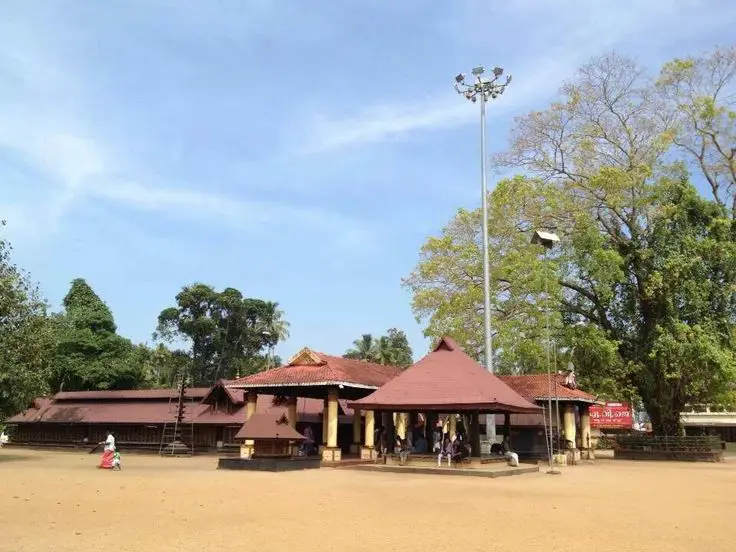
Nestled in the verdant landscapes of Alappuzha, the Chettikulangara Bhagavathy Temple stands as a beacon of divine grace and cultural richness. Dedicated to the powerful goddess Bhagavathy, this ancient temple has been a revered pilgrimage site for centuries. Join us on a virtual journey as we explore the sacred sanctum, vibrant traditions, and spiritual significance of the Chettikulangara Bhagavathy Temple.
Historical Tapestry:
- The Chettikulangara Bhagavathy Temple weaves itself into the historical tapestry of Kerala, with its origins shrouded in the mists of time. The temple’s ancient roots resonate with the rich cultural and spiritual heritage of the region.
Goddess Bhagavathy:
- The presiding deity of the temple is Goddess Bhagavathy, a manifestation of divine femininity and power. Devotees believe that seeking the blessings of Bhagavathy brings protection, prosperity, and liberation from worldly woes.
Architectural Grandeur:
- The temple’s architecture is a captivating blend of traditional Kerala style and intricate detailing. The towering gopuram, adorned with vibrant sculptures and carvings, reflects the artistic prowess of the craftsmen who contributed to its construction.
Festivals and Celebrations:
- The Chettikulangara Bhagavathy Temple is renowned for its grand festivals and celebrations. The annual Bharani Festival, marked by vibrant processions, traditional music, and cultural performances, draws devotees and tourists from far and wide.
Kuthiyottam Ritual:
- A unique ritual associated with the temple is the Kuthiyottam, a traditional dance performance offered as a form of devotion during the Bharani Festival. The rhythmic beats and graceful movements of the performers add to the festive fervor.
Makam Thozhal:
- The Makam Thozhal is another significant event at the Chettikulangara Bhagavathy Temple. Devotees gather to offer prayers and seek the divine blessings of the goddess during this auspicious occasion.
Poojas and Offerings:
- The temple follows a rich schedule of daily poojas and offerings. The fragrance of incense, the rhythmic chanting of prayers, and the glow of oil lamps create a serene ambiance that enhances the spiritual experience for devotees.
Devotee Pilgrimage:
- The Chettikulangara Bhagavathy Temple attracts a constant stream of devotees throughout the year. Pilgrims undertake spiritual journeys to seek solace, blessings, and a connection with the divine in the sacred precincts of the temple.
Cultural Legacy:
- The temple has played a pivotal role in preserving and promoting Kerala’s cultural legacy. Traditional art forms, music, and dance find expression in the various cultural events held in and around the temple premises.
Community Engagement:
- The Chettikulangara Bhagavathy Temple actively engages with the local community. Apart from its religious functions, the temple contributes to social welfare activities, fostering a sense of unity and compassion within the region.
Punnapra: Unveiling the Rich Tapestry of History and Culture

Nestled along the enchanting backwaters of Kerala, Punnapra emerges as a quaint yet historically significant town, offering a unique blend of cultural heritage and natural beauty. This unassuming locale, situated near Alappuzha, carries the echoes of a rich past, contributing to the cultural tapestry of God’s Own Country. Join us on a virtual journey as we explore the hidden gems and historical allure of Punnapra.
Historical Significance:
- Punnapra’s historical significance is deeply rooted in the pages of India’s struggle for independence. The town gained prominence during the Punnapra-Vayalar uprising of 1946, a pivotal moment in Kerala’s history when the local populace protested against social and economic injustices.
Punnapra-Vayalar Uprising:
- The Punnapra-Vayalar Uprising marked a watershed moment in the agrarian struggles of Kerala. The protests, which culminated in October 1946, witnessed the participation of thousands of farmers and laborers, demanding fair wages and better working conditions.
Monuments and Memorials:
- Punnapra pays homage to its historical legacy through various monuments and memorials dedicated to those who participated in the uprising. Visitors can explore these landmarks to gain insights into the courage and resilience of the people who fought for their rights.
Backwater Beauty:
- Punnapra is blessed with the serene charm of Kerala’s backwaters. The tranquil canals and lush greenery create a picturesque setting, providing visitors with an opportunity to unwind and connect with nature.
Fishing Communities:
- The backwaters of Punnapra are home to vibrant fishing communities. Visitors can witness the traditional fishing techniques employed by locals and engage with the community to gain a deeper understanding of their way of life.
Cultural Diversity:
- Punnapra is a melting pot of cultural diversity, reflecting the communal harmony that defines Kerala. The town celebrates various festivals and cultural events throughout the year, providing a glimpse into the traditions and customs of its residents.
Punnapra Beach:
- Punnapra Beach, though less crowded than some of its counterparts, offers a tranquil retreat by the Arabian Sea. The golden sands and gentle waves create a serene ambiance, making it an ideal spot for a peaceful beachside escape.
Artistic Expression:
- The town is known for fostering artistic expression. Local artists often find inspiration in Punnapra’s historical narratives and natural beauty, contributing to the vibrant art scene that adds a touch of creativity to the town.
Agricultural Practices:
- Punnapra’s agrarian landscape showcases traditional agricultural practices. Visitors can witness the cultivation of paddy fields, coconut groves, and other crops that form the backbone of the region’s agrarian economy.
Culinary Delights:
- Punnapra introduces visitors to the authentic flavors of Kerala. Local eateries offer delectable seafood dishes, coconut-infused curries, and traditional delicacies, providing a gastronomic journey into the heart of Kerala’s culinary heritage.
Edathua Church: A Divine Tapestry of Faith and Architectural Splendor
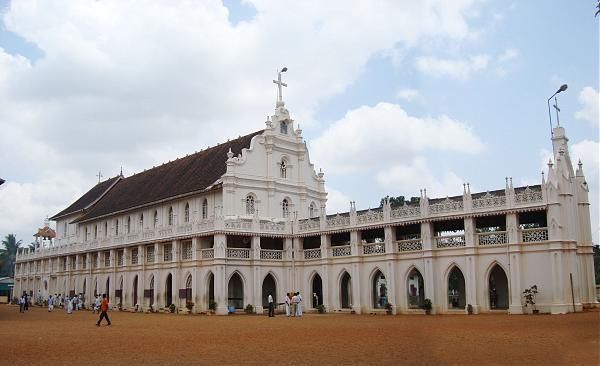
Nestled along the serene banks of the Pamba River in Kerala, Edathua Church stands as a testament to unwavering faith and architectural brilliance. Dedicated to St. George, the patron saint of Edathua, this sacred edifice has become a pilgrimage site drawing devotees and travelers alike. Join us on a virtual journey as we explore the spiritual sanctity, cultural significance, and architectural grandeur of Edathua Church.
Historical Roots:
- Edathua Church’s roots extend deep into Kerala’s Christian history. Established over a century ago, the church has evolved as a symbol of religious devotion, preserving the sacred traditions of the Christian community in the region.
Architectural Marvel:
- The church’s architecture is a captivating fusion of classical European and indigenous Kerala styles. The towering spires, Gothic arches, and intricate detailing reflect the meticulous craftsmanship of the builders, creating a visual spectacle that stands out against the lush green backdrop.
Patron Saint St. George:
- St. George, the revered patron saint of Edathua Church, is venerated for his role as a protector and intercessor. Devotees believe that seeking the saint’s blessings brings courage, protection, and spiritual strength.
Annual Feast of St. George:
- The highlight of Edathua Church’s calendar is the annual feast dedicated to St. George. The feast, celebrated with grandeur and devotion, attracts pilgrims from far and wide who participate in processions, prayers, and cultural events.
Miraculous Healing:
- Edathua Church is renowned for its association with miraculous healings. Many devotees attribute their recoveries to the intercession of St. George, and the church has become a place of solace and hope for those seeking divine intervention.
Religious Practices:
- The church follows a rich tapestry of religious practices, including daily masses, novenas, and special ceremonies. The ethereal atmosphere within the church, accompanied by the harmonious chants and the flickering glow of candles, enhances the spiritual experience.
Festive Decorations:
- During religious festivals, Edathua Church comes alive with vibrant decorations. Colorful floral arrangements, illuminated arches, and traditional artwork contribute to the festive ambiance, creating a visually stunning backdrop for worship.
Religious Artifacts:
- The church houses a collection of religious artifacts, including ornate altars, statues, and paintings. Each piece reflects the cultural and religious heritage of the Christian community in Kerala.
Devotional Practices:
- Devotees engage in various devotional practices, such as lighting candles, offering prayers, and seeking the intercession of St. George. The church provides a serene environment for personal reflection and spiritual connection.
Cultural Heritage:
- Edathua Church actively contributes to Kerala’s cultural heritage. Beyond its religious functions, the church hosts cultural events, showcasing traditional music, dance, and art forms, fostering a sense of community and cultural pride.
Alleppey Lighthouse: Guiding Light to Kerala’s Coastal Beauty
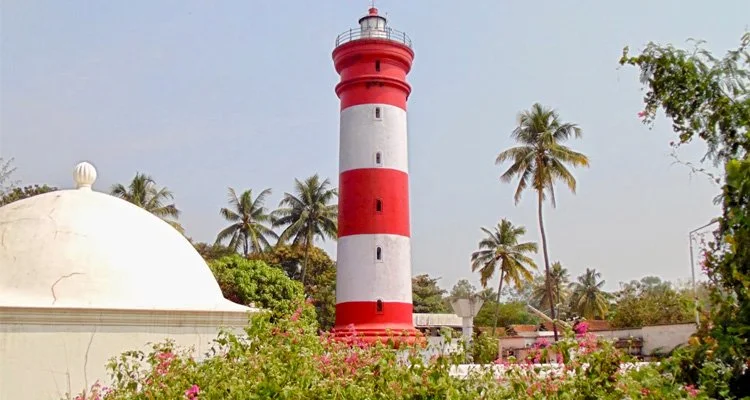
Perched majestically on the shores of the Arabian Sea, the Alleppey Lighthouse stands as both a sentinel overlooking the vast expanse of the ocean and a symbol of maritime history. This iconic structure in the coastal town of Alleppey, also known as Alappuzha, invites travelers to ascend its heights for panoramic views and a journey into Kerala’s maritime heritage. Join us as we explore the allure and significance of the Alleppey Lighthouse.
Historical Maritime Heritage:
- The Alleppey Lighthouse is not just a towering structure; it represents a vital chapter in Kerala’s maritime history. Built in 1862, it served as a guiding light for ships navigating the treacherous waters of the Arabian Sea.
Architectural Splendor:
- The lighthouse’s architecture is a captivating blend of colonial and indigenous styles. Its distinctive red and white stripes add to its visual appeal, making it a prominent landmark along Alleppey’s coastline.
Strategic Location:
- Positioned strategically near the Alleppey Beach, the lighthouse offers breathtaking views of the Arabian Sea and the surrounding landscapes. Its location makes it a popular destination for both locals and tourists seeking a vantage point to admire the coastal beauty.
Navigational Aid:
- In its early days, the Alleppey Lighthouse served as a crucial navigational aid for maritime activities in the region. The guiding light helped ships safely navigate the waters, avoiding potential dangers along the coastline.
Panoramic Views from the Top:
- Ascending the spiral staircase to the top of the lighthouse is a rewarding experience. From the observation deck, visitors are treated to panoramic views of the Arabian Sea, Alleppey Beach, and the picturesque landscapes that define Kerala’s coastal charm.
Maintaining Maritime Tradition:
- While modern navigation technology has diminished the lighthouse’s primary role, it continues to maintain the maritime tradition. The Alleppey Lighthouse stands as a symbol of the region’s seafaring history and the evolution of navigation.
Tourist Attraction:
- Today, the Alleppey Lighthouse has transformed into a popular tourist attraction. Visitors can explore the lighthouse compound, learn about its history, and climb to the top for a mesmerizing view of the coastal panorama.
Alleppey Beach Promenade:
- The lighthouse is an integral part of the Alleppey Beach promenade. The sandy shores, coupled with the backdrop of the lighthouse, create a tranquil setting for leisurely strolls and enjoying the natural beauty of the coastline.
Cultural Significance:
- The Alleppey Lighthouse is not just a functional structure; it holds cultural significance for the local community. It symbolizes resilience, continuity, and the enduring connection between the people of Alleppey and the sea.
Sunset Spectacle:
- Sunset at the Alleppey Lighthouse is a spectacle to behold. As the sun dips below the horizon, the lighthouse casts a long shadow over the beach, creating a magical ambiance that attracts photographers and nature enthusiasts alike.
Chavara Bhavan: A Spiritual Haven on Kerala’s Coastal Shores
Nestled along the pristine shores of the Arabian Sea in Kerala, Chavara Bhavan stands as a spiritual sanctuary and a beacon of inspiration for devotees and visitors alike. This revered pilgrimage site, dedicated to the saintly figure Kuriakose Elias Chavara, holds a rich tapestry of religious history and cultural significance. Join us on a virtual journey as we explore the tranquil ambiance, historical legacy, and spiritual allure of Chavara Bhavan.
The Saintly Figure – Kuriakose Elias Chavara:
- Chavara Bhavan is dedicated to Kuriakose Elias Chavara, a saintly figure who played a pivotal role in shaping the spiritual landscape of Kerala. A visionary, educator, and social reformer, Chavara’s teachings continue to resonate with the faithful.
Historical Origins:
- Chavara Bhavan has its roots in the 18th century when it served as the ancestral home of the Chavara family. The site holds historical significance as the birthplace of Kuriakose Elias Chavara and his illustrious siblings.
Spiritual Retreat and Pilgrimage Center:
- Today, Chavara Bhavan has transformed into a spiritual retreat and pilgrimage center, attracting devotees seeking solace, spiritual guidance, and a connection with the saint’s legacy. Pilgrims come to pay homage to the saint and seek blessings for their families.
Chavara Bhavan Chapel:
- The Chapel within Chavara Bhavan is a place of deep spirituality. Devotees participate in prayers, meditations, and religious ceremonies, creating a serene ambiance conducive to introspection and devotion.
St. Kuriakose Elias Chavara Museum:
- The museum at Chavara Bhavan provides a glimpse into the life and contributions of St. Kuriakose Elias Chavara. Exhibits include artifacts, manuscripts, and memorabilia, allowing visitors to delve into the saint’s rich legacy.
Educational Contributions:
- St. Kuriakose Elias Chavara was a pioneer in education, establishing schools that emphasized both academic and moral development. Chavara Bhavan pays tribute to this aspect of his legacy, contributing to the education and cultural heritage of the region.
Chavara Bhavan Library:
- The library within Chavara Bhavan is a treasure trove of religious literature, manuscripts, and historical documents. It serves as a resource for scholars, researchers, and those seeking a deeper understanding of Kerala’s Christian heritage.
St. Kuriakose Elias Chavara Pilgrim Center:
- Chavara Bhavan is a designated pilgrim center that attracts devotees from across the country and beyond. The center organizes religious events, retreats, and seminars, fostering a sense of community among the faithful.
Annual Feast Celebrations:
- The annual feast of St. Kuriakose Elias Chavara is a grand celebration at Chavara Bhavan. Pilgrims participate in processions, religious ceremonies, and cultural events that mark this significant occasion.
Cultural and Spiritual Harmony:
- Chavara Bhavan stands as a testament to the cultural and spiritual harmony that defines Kerala. Devotees from various backgrounds come together to celebrate the saint’s teachings, fostering a sense of unity and brotherhood.
Arthunkal Church: A Spiritual Oasis on the Shores of Alleppey

Nestled on the picturesque shores of the Arabian Sea in Alleppey, the Arthunkal Church, officially known as St. Andrew’s Basilica Arthunkal, is a testament to faith, history, and the enduring spirit of Kerala’s Christian community. This revered pilgrimage site draws devotees from far and wide, inviting them to experience the divine tranquility and cultural richness that define this sacred edifice. Join us on a virtual pilgrimage as we explore the spiritual significance, historical legacy, and cultural allure of Arthunkal Church.
Religious Heritage:
- Arthunkal Church stands as a beacon of Kerala’s Christian religious heritage. Its roots trace back to the arrival of Portuguese missionaries in the 16th century, marking the beginning of a vibrant Christian community in the region.
Patron Saint St. Sebastian:
- The church is dedicated to St. Sebastian, the patron saint invoked for protection against diseases. Devotees believe that seeking the intercession of St. Sebastian at Arthunkal Church brings healing and divine intervention.
Historical Origins:
- The origins of Arthunkal Church date back to the 16th century when it was established by Portuguese missionaries. Over the centuries, it has undergone several renovations, evolving into the magnificent basilica that stands today.
Religious Practices:
- Arthunkal Church follows a rich tapestry of religious practices, including daily masses, novenas, and processions. The rhythmic chants, the fragrance of incense, and the solemn ambiance create a sacred space for prayer and reflection.
Annual Feast of St. Sebastian:
- The annual feast of St. Sebastian is a grand celebration at Arthunkal Church. Pilgrims and devotees from different parts of the country participate in the festivities, marked by processions, liturgical ceremonies, and cultural events.
Miraculous Healing Waters:
- Arthunkal Church is renowned for its miraculous healing waters. Pilgrims believe that the water from the church well, known as “Arukala Kinaru,” possesses healing properties, and bathing in it is a sacred ritual for seeking blessings and cures.
Religious Art and Architecture:
- The church’s architecture is a blend of European and indigenous styles, featuring intricate detailing and vibrant stained glass windows. The religious art within the church depicts scenes from the life of St. Sebastian, adding to the spiritual ambiance.
Cultural Significance:
- Arthunkal Church is not only a religious site but also a cultural landmark. It plays a pivotal role in preserving and promoting Kerala’s Christian cultural heritage through traditional art, music, and festivals.
Arthunkal Perunnal:
- Arthunkal Perunnal, the annual feast, attracts a multitude of devotees. The religious procession, accompanied by traditional music and cultural performances, transforms the surroundings into a vibrant tapestry of faith and celebration.
Devotee Pilgrimage:
- The allure of Arthunkal Church extends beyond the local community. Devotees from across the country and beyond embark on pilgrimages to seek solace, spiritual renewal, and the blessings of St. Sebastian.
Alleppey CSI Christ Church: A Haven of Tranquility and Historical Grace
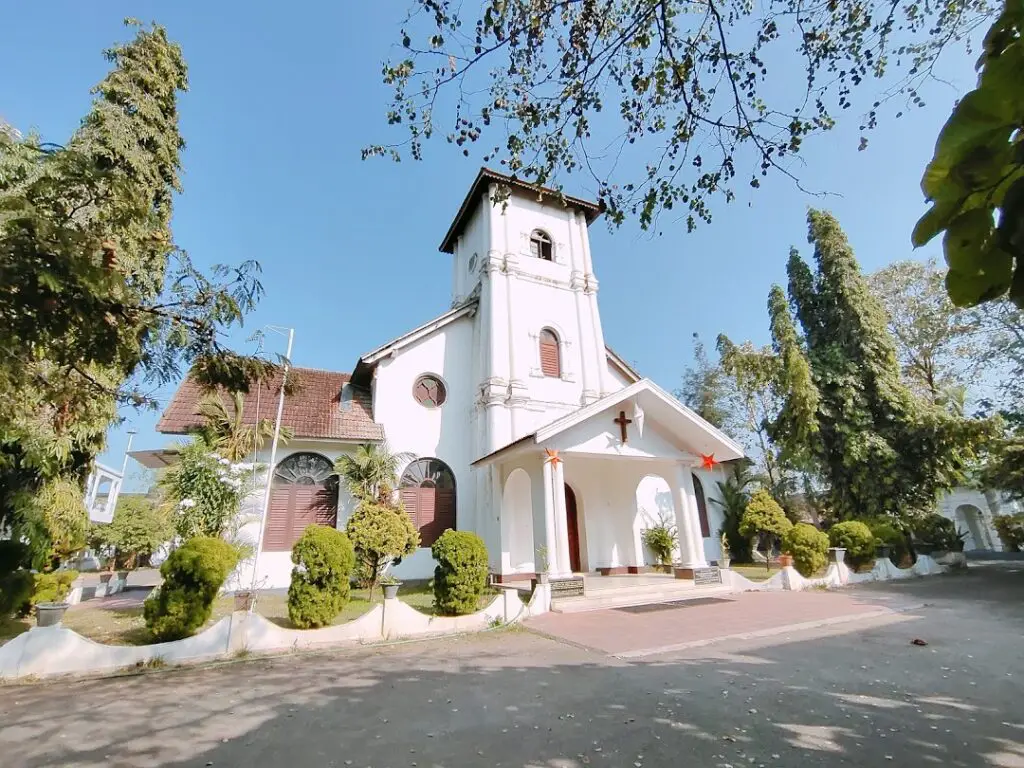
Nestled in the heart of Alleppey, a town known for its serene backwaters and cultural richness, the CSI Christ Church stands as an embodiment of faith, history, and architectural elegance. As a prominent landmark and spiritual sanctuary, this church holds a unique place in the cultural tapestry of God’s Own Country. Join us on a virtual journey as we explore the spiritual significance, historical legacy, and architectural splendor of Alleppey CSI Christ Church.
Christianity in Alleppey:
- The presence of CSI Christ Church in Alleppey is a testament to the deep-rooted Christian community in the region. As one of the oldest churches, it has played a pivotal role in shaping the religious landscape of Alleppey.
Historical Roots:
- Established during the British colonial era, CSI Christ Church has witnessed the changing tides of time. Its historical roots are intertwined with the colonial history of Kerala, making it a repository of cultural and religious heritage.
Church of South India (CSI) Affiliation:
- The church is affiliated with the Church of South India (CSI), a union of various Protestant denominations. The CSI Christ Church reflects the inclusivity and diversity of the Christian faith in the region.
Architectural Grandeur:
- The architecture of CSI Christ Church is a harmonious blend of colonial and traditional Kerala styles. Its whitewashed walls, Gothic windows, and a distinctive spire stand as a testament to the architectural brilliance of a bygone era.
Spiritual Sanctuary:
- The serene ambiance within the church creates a spiritual sanctuary for worshipers and visitors alike. The peaceful interior, adorned with stained glass windows and wooden furnishings, provides a tranquil space for prayer and reflection.
Religious Services:
- CSI Christ Church conducts regular religious services, including Sunday worship, prayer meetings, and special ceremonies. The hymns, prayers, and sermons contribute to the spiritual vibrancy that permeates the church.
Historical Artifacts:
- The church houses historical artifacts that narrate its own story and that of the Christian community in Alleppey. Visitors can explore artifacts, documents, and memorabilia that showcase the church’s journey through time.
Cultural Celebrations:
- CSI Christ Church actively participates in and hosts cultural celebrations, marking significant events in the Christian calendar. Festivals such as Christmas and Easter are celebrated with joy, music, and communal gatherings.
Community Engagement:
- The church plays a pivotal role in community engagement, contributing to social welfare activities and fostering a sense of unity among its congregation. Outreach programs, charity initiatives, and educational efforts are integral to the church’s mission.
Heritage Preservation:
- CSI Christ Church actively engages in the preservation of its heritage. Restoration and conservation efforts ensure that the church continues to stand as a symbol of historical grace and cultural continuity.
Sree Subramanya Swamy Temple: A Spiritual Abode Amidst Nature’s Beauty
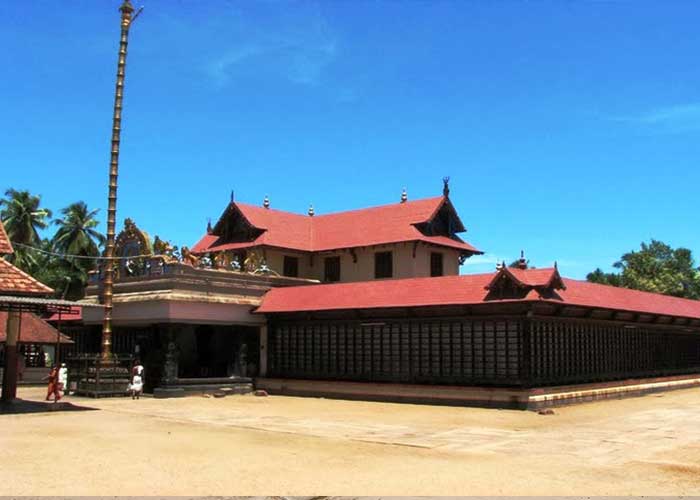
Nestled amidst the lush greenery of Kerala, the Sree Subramanya Swamy Temple stands as a divine abode dedicated to Lord Murugan, the son of Lord Shiva and Parvati. This sacred temple, enveloped in natural beauty, beckons devotees and seekers alike to experience the spiritual serenity and cultural richness that define its hallowed grounds. Join us on a virtual pilgrimage as we explore the significance, history, and unique charm of the Sree Subramanya Swamy Temple.
Spiritual Significance:
- The Sree Subramanya Swamy Temple is revered by devotees as a sacred site dedicated to Lord Murugan, also known as Kartikeya or Subramanya. Lord Murugan is worshipped as the epitome of wisdom, courage, and victory over obstacles.
Idyllic Location:
- Situated amidst the scenic beauty of Kerala, the temple is often surrounded by lush greenery, adding a tranquil and idyllic touch to its surroundings. The natural setting enhances the spiritual ambiance, making it a peaceful retreat for worshipers.
Lord Murugan:
- Lord Murugan, the principal deity of the temple, is worshipped with fervor and devotion. The deity is often depicted with six faces and twelve hands, symbolizing divine attributes and cosmic significance.
Traditional Architecture:
- The temple’s architecture is a testament to traditional Kerala style. Intricately carved pillars, vibrant murals, and the iconic gopuram reflect the architectural grandeur that adds to the spiritual charm of the Sree Subramanya Swamy Temple.
Religious Practices:
- Daily rituals and pujas are an integral part of the temple’s religious practices. Devotees gather to offer prayers, light lamps, and participate in the rhythmic chants that fill the air with a sense of divine devotion.
Thaipooyam Festival:
- The Thaipooyam festival celebrated at the Sree Subramanya Swamy Temple is a grand occasion. Devotees from various parts of the country participate in the vibrant processions, cultural events, and rituals that mark this auspicious festival.
Spiritual Retreats:
- The temple serves as a spiritual retreat for seekers looking to connect with the divine in a serene environment. Meditation and contemplation within the temple premises offer a tranquil escape from the hustle and bustle of daily life.
Pilgrimage Destination:
- Devotees undertake pilgrimages to the Sree Subramanya Swamy Temple seeking the blessings of Lord Murugan. The journey to the temple is often considered a sacred endeavor, symbolizing devotion and spiritual commitment.
Cultural Heritage:
- The temple actively contributes to preserving Kerala’s cultural heritage. Traditional art forms, music, and dance often find expression in the cultural events and festivals hosted within the temple premises.
Nature’s Harmony:
- The seamless integration of the temple with its natural surroundings reflects the harmonious relationship between spirituality and nature. The temple becomes a place where devotees can connect with the divine while being enveloped in the soothing embrace of the natural world.
Mannarasala Nagaraja Temple: Serpent Worship and Spiritual Harmony in Kerala

Nestled in the verdant landscapes of Haripad in Kerala, the Mannarasala Nagaraja Temple stands as a unique and sacred abode dedicated to serpent worship. With a history steeped in mythology and a serene ambiance surrounded by dense forests, this temple holds a distinctive place in Kerala’s spiritual landscape. Join us on a virtual journey as we unravel the mystique, cultural significance, and spiritual charm of Mannarasala Nagaraja Temple.
Serpent Worship Tradition:
- Mannarasala Nagaraja Temple is renowned for its distinctive tradition of serpent worship, a practice deeply rooted in Hindu mythology and Kerala’s cultural heritage. The presiding deity, Nagaraja, is considered the king of serpents.
Mythological Roots:
- According to mythology, Mannarasala Nagaraja Temple is associated with the legendary tale of Parasurama, the sixth avatar of Lord Vishnu. The temple is believed to have been installed by Parasurama himself, and the divine serpents are said to be his protectors.
Sacred Groves and Serene Ambiance:
- Surrounded by sacred groves and dense foliage, Mannarasala Temple exudes a serene and mystical ambiance. The temple complex is dotted with ancient trees, creating a tranquil setting that enhances the spiritual experience for devotees.
Unique Sanctum Sanctorum:
- The sanctum sanctorum of Mannarasala Nagaraja Temple is unique, with the main deity represented as a serpent idol. Devotees offer special prayers and rituals to seek the blessings of Nagaraja for fertility, protection, and well-being.
Uruli Kamazhthal Ritual:
- One of the distinctive rituals at Mannarasala Temple is the Uruli Kamazhthal, where women offer a special vessel (uruli) to the serpent deity as an offering. This ritual is believed to bring blessings for childless couples.
Harvest Festival – Ayilyam Puja:
- The Ayilyam Puja, celebrated during the Ayilyam star in the Malayalam month of Thulam (October-November), is a grand event at Mannarasala Temple. Devotees throng the temple to participate in the festivities and seek the blessings of Nagaraja.
Nagaraja Temple Festival:
- The annual festival of Mannarasala Nagaraja Temple is a vibrant celebration marked by processions, cultural events, and rituals. Devotees from various parts of Kerala and beyond participate in the festivities, creating a joyous and spiritual atmosphere.
Conservation of Snake Groves:
- The temple actively engages in the conservation of snake groves, contributing to environmental preservation. The sacred groves around Mannarasala are considered essential for the well-being of the temple and its unique tradition.
Cultural Legacy:
- Mannarasala Nagaraja Temple is a custodian of Kerala’s cultural legacy, preserving ancient traditions and rituals associated with serpent worship. The temple’s rituals and festivals provide a glimpse into the cultural richness of the region.
Conclusion
Alleppey in 2024 promises a delightful blend of natural beauty and cultural richness. From serene backwaters to golden beaches, religious landmarks to colonial charm, each destination offers a unique experience. Whether exploring historic sites, joining cultural festivities, or relaxing on pristine beaches, Alleppey invites you to create unforgettable memories in the coming year.
FAQs
What makes Alleppey a must-visit destination in 2024?
Alleppey, known for its enchanting backwaters, serene beaches, and cultural heritage, offers a diverse range of experiences. The unique blend of natural beauty, historic landmarks, and cultural festivities makes it a compelling destination in 2024.
How can I explore the Alleppey Backwaters?
The best way to explore the Alleppey Backwaters is by taking a houseboat cruise. These traditional boats offer a leisurely journey through the scenic waterways, allowing you to immerse yourself in the beauty of Kerala’s landscapes.
Which festivals are celebrated in Alleppey, and when is the best time to witness them?
Alleppey hosts various festivals throughout the year, including the Nehru Trophy Boat Race and the Kumbha Bharani Utsavam. The best time to witness these vibrant celebrations is during the respective festival seasons, usually in August and February.
Are there any historical landmarks in Alleppey?
Yes, Alleppey boasts several historical landmarks, including the Krishnapuram Palace, known for its archaeological museum, and the colonial-era CSI Christ Church with its unique architecture.
What are the popular activities to do in Alleppey?
Popular activities in Alleppey include houseboat cruises on the backwaters, beach relaxation at Marari Beach, exploring cultural and religious sites, and participating in local festivals to experience the rich heritage of the region.
Can I visit Alleppey for a spiritual retreat?
Absolutely! Alleppey offers various spiritual retreats, such as visiting temples like Mannarasala Nagaraja Temple and St. Mary’s Forane Church, where you can experience serenity and immerse yourself in religious practices.
What are the unique features of Mannarasala Nagaraja Temple?
Mannarasala Nagaraja Temple is unique for its serpent worship tradition. Devotees believe in the healing powers of the temple’s sacred groves, and the temple hosts special rituals like Uruli Kamazhthal and the annual Ayilyam Puja.
Which beaches are recommended for a peaceful retreat in Alleppey?
For a peaceful retreat, Punnapra Beach and Marari Beach are recommended. These pristine beaches offer tranquility and are perfect for unwinding amidst nature’s beauty.
Is Alleppey suitable for family vacations?
Yes, Alleppey is an excellent destination for family vacations. The backwaters, beaches, and cultural sites offer a variety of activities suitable for all age groups.
How can I participate in the cultural celebrations in Alleppey?
To participate in cultural celebrations, plan your visit during major festivals like the Nehru Trophy Boat Race or the Kumbha Bharani Utsavam. Joining processions, witnessing traditional performances, and interacting with locals are great ways to immerse yourself in the cultural vibrancy of Alleppey.




